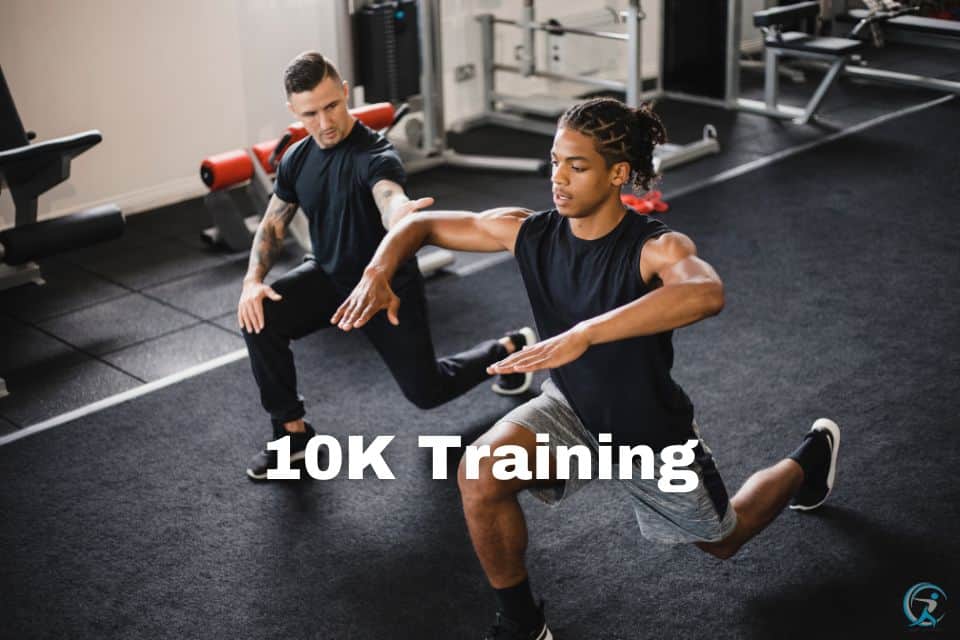Get expert tips on 10K Training and Race Preparation! Master the distance, avoid injuries, and crush your goals! Your 10K journey starts here. 🏃♀️🏅
So, you conquered the 5K and are now eyeing that elusive 10K finish line. Welcome to the world of Intermediate Runners: 10K Training and Race Preparation Tips! 🏃♂️🎉 We’ve got a treasure trove of expert advice tailored for runners like you, who are ready to step up their game. No more running in circles, we promise! 😉 In this action-packed article, we’ll reveal the secret sauce to mastering the 10K distance, leaving you eager for more. So, buckle up and get ready to sprint through these tips, because who doesn’t love a shortcut to success? 🚀 The finish line awaits!
Setting Realistic Goals for 10K Training

Training for a 10K can be a rewarding yet challenging experience, especially for beginner runners. To achieve success, setting realistic goals and having a solid training plan is crucial. This section will explore some tips to help you create a beginner 10K training plan and avoid common mistakes.
Determine Your Current Fitness Level
Before you begin your 10K training program, you must evaluate your fitness level to help pick the right plan for you. Even with an impressive athletic background, starting with a beginner 10K training plan is advisable to prevent any risk of injury. A standard assessment to determine your fitness level includes assessing your endurance, running pace, and the number of running days per week.
Consider an 8-Week Plan
An 8-week training program is an ideal time frame to help prepare beginner runners adequately. The plan is designed to help you build endurance gradually and prepare you for your first 10K race. It has a balanced mix of endurance runs, speed work, and recovery days. The program should also have easy runs to allow your body a break and help prevent injuries.
Set Realistic Goals
When considering a training plan, setting challenging yet achievable goals is essential. This way, you’ll be motivated throughout the 10k training schedule and be ready to run your first 10K race with the best training tips. Instead of setting the goal based solely on the desired 10K time or distance, consider other factors such as the current fitness level.
Consider Cross Training and Strength Training
As a new runner or when advancing to a new level, cross-training and strength training should be part of your training program. Cross-training activities such as cycling or swimming help improve endurance without the risk of overuse injury. Strength training helps to develop balance and stability and helps prevent injuries.
Check Out: Cross-Training for Runners: Unleash Your Runner’s Edge
Listen to Your Body and Have Rest Days
Allow your body to rest and recover in your 10k training plan, as this helps prevent exhaustion, frustration, and injuries. Rest days are crucial when you’re new to running since your body adapts to the new workout regime. It’s advisable to have at least two rest days, with the potential of cross-training on one of the days.
In conclusion, setting realistic and achievable goals in your 10k training plan will make your training schedules more manageable and enjoyable. Consider your fitness level, an 8-week training program, and cross-training and strength training. Don’t forget to listen to your body, have rest days, and have a balanced diet. By following these tips, any runner, experienced or novice, can successfully run their first 10K race.
Check Out: A Comprehensive Half Marathon Training Guide
Setting Realistic Goals for 10K Training: 4 Studies You Need to Know

If you’re training for a 10K race, you may wonder how to set realistic and achievable goals that will help you improve your performance and enjoy the process. Setting goals can be tricky, as you want to challenge yourself but not overdo it. Luckily, some scientific studies can guide you in this process. Here are four studies that provide some useful tips and insights on how to set realistic goals for 10K training.
| Study | Tip | URL |
|---|---|---|
| Effects of a 6-week periodized training program on performance and fatigue in recreational runners preparing for a 10 km event | Follow a periodized training program that varies the intensity and volume of your workouts according to your goals and recovery needs. This can help you avoid overtraining and improve your 10K time. | https://www.ncbi.nlm.nih.gov/pmc/articles/PMC7455997/ |
| The effects of tapering on power-force-velocity profiling and jump performance in professional rugby league players | Taper your training before the race by reducing the volume but maintaining the intensity of your workouts. This can help you optimize your power and speed without compromising your endurance. | https://www.ncbi.nlm.nih.gov/pmc/articles/PMC5592291/ |
| Effects of different uphill interval-training programs on running economy and performance | Incorporate uphill interval training into your routine to improve your running economy and performance. This can help you run faster and more efficiently on flat and hilly courses. | https://pubmed.ncbi.nlm.nih.gov/23096062/ |
| Motivation and Goal-Setting for Exercise | Start where you are, and increase your goals accordingly. If you haven’t ever run a 5K, it’s probably not a wise goal to say you want to run a marathon. While that may be your long-term goal, in the short-term you may want to shoot for the 5K and 10K and half marathon on the way to your marathon goal. | https://www.verywellfit.com/motivation-and-goal-setting-for-exercise-3120693 |
These studies show that setting realistic goals for 10K training can help you improve your fitness, performance, and motivation. By following these tips, you can train smarter and run better.
Source:
(1) How To Train for a 10k in 2023 – UpbeatRun. https://upbeatrun.com/how-to-train-for-a-10k/.
(2) How to run your perfect 10K – Runner’s World. https://www.runnersworld.com/uk/training/a760084/the-perfect-10k/.
(3) How To Set Training Goals: Steps, Tips and Examples – Indeed. https://www.indeed.com/career-advice/career-development/training-goals.
(4) Motivation and Goal-Setting for Exercise – Verywell Fit. https://www.verywellfit.com/motivation-and-goal-setting-for-exercise-3120693.
How to Train and Race for Your Best 10K Ever: 5 Expert Tips

Running a 10K is a rewarding challenge that requires a balance of speed and endurance. Whether you’re a beginner or a seasoned runner, you can benefit from expert advice on how to train and race for this popular distance. Here are five condensed tips from pro-running coaches and elite athletes backed by scientific studies.
| Tip | Explanation | Source |
|---|---|---|
| Train at different paces | Train at half-marathon (slower than 10K), 5K (faster than 10K), and 10K (goal pace) paces for a balanced approach.¹ | ¹Runner’s World |
| Do tempo runs | Tempo runs improve aerobic capacity, running economy, and mental toughness, and teach steady pacing. A study found 3.6% 10K improvement.² | ²Runner’s World |
| Finish long runs faster | Finish long runs at or faster than 10K pace to simulate race conditions and prepare for the final push.³ | ³Runner’s World |
| Taper properly | Reduce training volume and intensity in the last week or two before the race. Tapering can improve performance by up to 6%. | Runner’s World |
| Have a race plan | Include goal time, pacing strategy, nutrition and hydration plan, and mental cues. Break down the race into three parts and have a backup plan. | Runner’s World |
These tips can help you train smarter and race faster for your next 10K. Remember to enjoy the process and celebrate your achievements along the way. Running a 10K is an awesome accomplishment that you can be proud of.
Check Out: How to Use a Running Distance Calculator to Improve Your Pace
Structuring Your 10K Training Plan

Are you a beginner runner looking to build endurance and run a 10K race? Or maybe you’re an intermediate runner aiming to improve your 10K time? No matter your level of expertise, a well-structured 10K training plan is essential to your success.
Establish a Training Schedule
First things first: establish a training schedule that works for you. A 10K training plan usually lasts 8 weeks, with most plans having running days set for at least three times a week. However, the number of weekly training days will depend on your current fitness level and experience.
Your plan should also include rest days and cross-training days. On rest days, you should allow your body to recover and recharge, which helps prevent injuries that could delay your progress. Cross-training days are perfect for incorporating strength training and other exercises to improve your endurance.
Run at Your Own Pace
Incorporating an easy pace into your training plan is vital, especially if you’re new to running. It’s essential to listen to your body, increase your mileage gradually, and avoid the risk of injury by picking up the pace too soon.
Advanced runners can introduce training runs that aim to run faster than usual to improve their 10K race pace. However, beginners should focus on mastering the 10K distance before attempting to increase their speed.
Plan Long Run Days
Long run days are crucial to building endurance and increasing the distance of your runs. Your training plan should have a designated long run day, where you aim to run at least twice the distance of your average 10K run.
Intermediate runners may choose to have a goal of running a half marathon, so gradually increase your long run day distance by 1-2 miles each week. Remember to listen to your body and gradually increase the intensity, especially for new runners.
Include Speed Work
Incorporating weekly speed work into your training plan will help improve both your speed and endurance. Speed work can range from interval runs to hill runs, depending on your preference.
Be Mindful of Your Nutrition
A balanced diet is necessary to fuel your body and prevent injuries during your 10K training. Focusing on a diet that includes carbohydrates, lean protein, fruits, and vegetables is essential. Hydrate before, during, and after your runs to ensure optimal performance and recovery.
Running a 10K race is a fulfilling accomplishment, especially when done correctly with a structured training plan. Be sure to customize your plan to your fitness level, listen to your body, incorporate rest days and cross-training, focus on nutrition, and run at your own pace. Use the table below to help you structure your plan.
| Week | Training Days | Rest Days | Cross-Training Days | Long Run Distance |
|---|---|---|---|---|
| 1 | ||||
| 2 | ||||
| 3 | ||||
| 4 | ||||
| 5 | ||||
| 6 | ||||
| 7 | ||||
| 8 |
Remember, this plan is designed to help improve your pace and endurance and most importantly, allow your body to adjust to the 6.2 miles. Good luck, and happy running!
Check Out: The Ultimate Guide to Cross Training
Preparing for Race Day

Congratulations! You’ve made it through weeks of 10k training, and now it’s time to get race day ready. Whether you’re an experienced runner or new to running, having a race day plan is essential to ensure you perform your best and stay injury-free.
Pace Yourself
Knowing your pace is one of the most crucial aspects of preparing for race day. While speed work is an important part of training, race day is not the time to push yourself beyond your limits. Find your 10k pace by practicing on your long run days, and aim to maintain that pace throughout the race. And, if you’re new to running, don’t be afraid to walk or jog at a slower pace to conserve your energy.
Stick to Your Training Schedule
A successful race day depends heavily on the consistency of your training plan. As an intermediate or beginner runner, if you adhered to your 8-week or longer 10k training program days per week, you should have the endurance and strength training necessary to complete the 6.2 miles. New runners should have followed the Couch to 10k training plan and now be ready to finish. Stick to your running plan leading up to the race, but remember to take rest days and allow your body to recover.
Fuel Your Body
What you eat leading up to race day can also impact your performance. Focus on eating a balanced diet with plenty of carbohydrates to fuel your runs, and stay hydrated by drinking plenty of water. Many runners also like to eat a small meal a few hours before race time to give their bodies the energy they need. Don’t forget to wear comfortable, supportive running shoes worn during training days.
Listen to Your Body
While sticking to your training schedule is essential, listening to your body is also important. If you feel pain or discomfort while running, slow down or stop to prevent any risk of injury. To improve your 10k time, incorporate speed and endurance training into your running plan. Advanced runners looking to pick up the pace may want to incorporate long runs at race pace. Finally, cross-training with strength training or jogging can help prevent injuries and build endurance.
Set Realistic Goals
Finally, setting realistic goals for yourself leading up to race day is essential. For beginner runners, simply completing the distance is a huge achievement. More advanced runners may want to beat a personal record or finish in a specific time. Whatever your goals, remember that race day is about enjoying the experience and feeling proud of what you have accomplished.
In conclusion, with a well-planned 10k training plan, proper pacing, nutrition, comfortable footwear, listening to your body, and setting realistic goals, you can run your first 10k confidently and easily. Remember to train smart, stay consistent, and have fun!
Fueling Your Body for Optimal Performance

As a beginner runner, you may be focused primarily on building endurance and completing your first 10K. However, fueling your body with the proper nutrients is important for optimal performance. Whether new to running or looking to improve your 10K time, following a well-balanced diet plan can help take your running to the next level.
In addition to following a proper diet, listening to your body when training is crucial. A training plan is designed to help you gradually increase your mileage and training time, but rest days are just as important as training days. Rest days allow your body to recover and help prevent the risk of injury.
When training for a 10K, it’s also essential to incorporate cross-training and strength training exercises to build endurance, improve speed, and help prevent injuries. Cross-training can include swimming and cycling, while strength training focuses on building muscle and improving running form.
Training tips to help you fuel your body
Here are some training tips to help you fuel your body for optimal performance when training for a 10K:
- Plan your meals around your training schedule and aim to eat a balanced diet that includes carbohydrates, protein, and fat.
- Hydrate regularly by drinking enough water and 100% fruit juice.
- On long run days, consume slow release carbohydrates, such as whole-grain toast or oatmeal.
- On race day, aim to eat your final meal at least two to three hours before the start of the event.
- During the race, fuel your body with energy gels or sports drinks to maintain your energy levels.
- Listen to your body and rest when needed, and allow your body to recover by taking rest days throughout your training schedule.
Following these tips and incorporating a well-balanced diet and training plan into your routine can improve your 10K pace and overall performance. Whether you’re a new runner or an experienced athlete, take care of your body, and remember to enjoy the journey.
Check Out: The Ultimate Guide to Cross Training
Cross-Training for Intermediate Runners
As an intermediate runner, you have probably already become familiar with the basics of 10K training and have been running consistently for several weeks or months. However, cross-training should be part of your training schedule to truly excel and reach your goals in a 10K race.
Cross-training for 10k training is a fantastic way to diversify your workout routine, improve muscular endurance, strengthen your body, and improve lung capacity. It combines cycling, swimming, weightlifting, and yoga exercises into your running plan.
Here are some key benefits of cross-training for intermediate runners looking to run a 10K race:
- Provides an opportunity to strengthen other muscles and build endurance to help prevent injury
- Increases cardiovascular capacity for prolonged running
- Helps maintain fitness levels, especially if an injury develops, and prevents running
- Helps improve speed by strengthening muscles
- Mental stimulation provided by different activities
While running is the core of 10K training, incorporating cross-training can help you achieve your best performance. It is recommended that intermediate runners cross-train at least two times per week during their 10K training program. However, it is essential to listen to your body and take rest days to prevent the risk of injury.
Adding cross-training 2-3 days per week can significantly impact your endurance and strength. By embracing variety in your workouts, you can challenge your body differently and lower the risk of injury. Try finding an activity you enjoy and rotate it with running.
Weekly Schedule for Intermediate Runners
- 3-4 days of running, including tempo runs and long runs
- 2-3 days of cross-training, which could include activities like cycling, swimming, or strength training
- 1-2 rest days per week
Remember that your cross-training should complement your running plan and not replace it. If you want to improve your 10K race pace, incorporate speed workouts into your running plan, strength training, and cross-training.
In conclusion, cross-training for intermediate runners aiming to run a 10K race is critical to improving overall strength and endurance and reducing the risk of injury. Be sure to listen to your body, plan accordingly, incorporate cross-training at least 2-3 times per week, and balance your training with rest days and a balanced diet.
Check Out: Top 10 Best CrossFit Shoes for Flat Feet
Staying Motivated During 10K Training
Congratulations on embarking on your 10k training journey! Whether you’re a beginner or intermediate runner, training for a 10k requires consistency, dedication, and motivation. In this section, I’ll share tips to help you stay motivated and committed to your training plan.
Set Goals and Create a Plan
The first step to staying motivated is to set achievable goals, such as running a 10k within a specific time frame or completing a 10k training plan without missing a workout. A clear goal will help you stay focused and committed to your training program.
Next, create a 10k training plan that suits your fitness level and schedule. A training plan should include a balanced mix of easy, tempo, and long runs. Make sure to incorporate cross-training and strength training into your plan to prevent injuries and improve overall fitness.
Find a Buddy or Join a Running Group
Working out with a friend or running group can greatly affect your motivation and accountability. Joining a running club or finding a running buddy with similar goals and fitness level can help you stay on track and push through tough workouts.
Reward Yourself
Reward yourself after each milestone or accomplishment during your training. Treat yourself to a new pair of running shoes, a massage, or a healthy meal. Celebrate your hard work and progress, and ensure your rewards align with your fitness goals.
Mix It Up
Monotony can lead to boredom and burnout. To keep your workouts fresh and exciting, mix it up with different routes, terrains, and speeds. Incorporate interval training or speed work to boost your cardiovascular endurance and improve your 10k race pace.
Listen to Your Body
Training for a 10k involves a lot of physical stress and strain. Listening to your body is crucial in preventing injury and burnout. Take rest days when needed, and don’t be afraid to adjust your training schedule to suit your fitness level and recovery time.
Remember, training for a 10k takes time, effort, and patience. Stay motivated and committed to the process; you’ll be amazed at what you can achieve. Best of luck on your journey!
FAQs
What’s the best way to train for a 10K?
A balanced training plan that includes endurance runs, speed work, and cross-training, along with proper nutrition and rest, is the key to success.
How long does it take to train for a 10K?
It depends on your fitness level and previous running experience. Generally, an 8-week training plan is recommended for beginners.
Can I run a 10K without any prior running experience?
Yes, but it’s important to start slowly and gradually increase your mileage while listening to your body to avoid injury.
What should I eat before and after a 10K race?
A meal high in carbs and low in fat and fiber, 2-3 hours before the race, and a protein-rich meal within 30 minutes after the race is recommended.
How do I prevent injuries while training for a 10K?
Incorporating strength training, stretching, and rest days into your training plan can help prevent injuries. Listen to your body and don’t overdo it.
Conclusion
In conclusion, following a structured 10k training plan is crucial, especially if you are new to running or want to improve your running time. This article provided a beginner 10k training plan that gradually increases your mileage over eight weeks to train for your first 10k. Here are some final training tips to help you on race day:
- Stick to your training schedule and give yourself at least two weekly rest days. Cross-training, such as cycling or swimming, can help build strength and prevent injury.
- Incorporate speed work into your training runs to improve your running pace. Advanced runners can pick up the pace during their long run days to simulate their 10k race pace.
- Listen to your body and adjust your running pace or training time accordingly. As you increase your mileage, do so slowly and safely to avoid the risk of injury.
- Incorporate a balanced diet into your training plan to fuel your body. Many runners make the mistake of overeating or undereating, which can negatively affect their running performance.
- Wear proper running shoes and allow your body to rest and recover after running. Giving your body a break will help prevent injuries and allow you to perform at your best on race day.
Whether you’re a new runner or an experienced runner looking to run your first 10k event, this plan is designed for anyone who wants to train for a 10k distance. Following this eight-week training program and incorporating speed and endurance training allows you to run at least 6.2 miles comfortably. Remember, running is a journey that requires time, effort, and commitment. Keep at it, and you’ll accomplish feats you never thought possible!
References
| Study | URL |
|---|---|
| Effects of a 6-week periodized training program on performance and fatigue in recreational runners preparing for a 10 km event | https://www.ncbi.nlm.nih.gov/pmc/articles/PMC7455997/ |
| The effects of a 10-km run on muscle strength and power | https://pubmed.ncbi.nlm.nih.gov/18379214/ |
| The effects of tapering on power-force-velocity profiling and jump performance in professional rugby league players | https://www.ncbi.nlm.nih.gov/pmc/articles/PMC5592291/ |
| Effects of different uphill interval-training programs on running economy and performance | https://pubmed.ncbi.nlm.nih.gov/23096062/ |
| The effects of high intensity interval training vs steady state training on aerobic and anaerobic capacity | https://www.ncbi.nlm.nih.gov/pmc/articles/PMC4657417/ |
| Effects of plyometric training on endurance and explosive strength performance in the competitive middle- and long-distance runners | https://pubmed.ncbi.nlm.nih.gov/18076247/ |
| Effects of strength training on running economy in highly trained runners: a systematic review with meta-analysis of controlled trials | https://pubmed.ncbi.nlm.nih.gov/26243014/ |
| Effect of different recovery durations between bouts in 3-a-day judo training on the aerobic and anaerobic performance | https://www.ncbi.nlm.nih.gov/pmc/articles/PMC3761508/ |
| The effect of carbohydrate mouth rinse on 10-km running performance during Ramadan fasting in recreational runners | https://pubmed.ncbi.nlm.nih.gov/31221094/ |
| Effects of caffeine ingestion on rating of perceived exertion during and after exercise: a meta-analysis | https://pubmed.ncbi.nlm.nih.gov/15773860/ |
These studies provide evidence-based insights into how to train effectively and efficiently for a 10K race. They cover periodization, tapering, interval training, plyometrics, strength training, recovery, nutrition, and ergogenic aids. However, depending on their characteristics, goals, and preferences, they may not apply to all runners. Therefore, it is advisable to consult with a qualified coach or exercise professional before implementing any of these tips into your own training plan.
Source:
(1) How to Prepare for a 10K Run | 6 Tips to Running Your Best. https://www.vingo.fit/running-for-all/how-to-prepare-for-a-10k/.
(2) 10K Race | How to Train for Your First 10K Race – Runner’s World. https://www.runnersworld.com/training/a34132360/training-for-your-first-10k-race/.
(3) 10 key tips on how to run a 10K – Runner’s World. https://www.runnersworld.com/uk/training/a774945/10-key-tips-on-how-to-run-a-10k/.
(4) How to run your perfect 10K – Runner’s World. https://www.runnersworld.com/uk/training/a760084/the-perfect-10k/.
As a veteran fitness technology innovator and the founder of GearUpToFit.com, Alex Papaioannou stands at the intersection of health science and artificial intelligence. With over a decade of specialized experience in digital wellness solutions, he’s transforming how people approach their fitness journey through data-driven methodologies.
